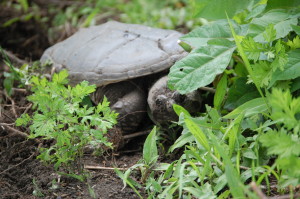 Many people spotted snapping turtles in early June lumbering across Irving Avenue, River Road, and Angell Street enroute to the Blackstone Park Conservation District to lay their eggs. It seemed inconceivable that these awkward-looking creatures could manage to get to their destinations without human assistance. But they did.
Many people spotted snapping turtles in early June lumbering across Irving Avenue, River Road, and Angell Street enroute to the Blackstone Park Conservation District to lay their eggs. It seemed inconceivable that these awkward-looking creatures could manage to get to their destinations without human assistance. But they did.
And now the reptiles have gone back to the ponds and river whence they came. Just as the Blackstone Parks Conservancy had asked a project manager to raise the newly installed temporary snow fencing in spots for the turtles to pass easily, the surge was over. They had not only crossed roads and climbed the steep bluffs as well as the split rail fencing atop the eastern bluff, but they had also managed to get around or under the snow fencing.
 The turtles’ nesting aligned with the lunar cycle and coincided with the installation of temporary fencing designed to protect planting along badly worn trails. Current work in the woods is part of the Trail Upgrade Project sponsored by the Rhode Island Department of Environmental Management (RIDEM) and the Coastal Resources Management Council (CRMC) to slow the rapid erosion of the Conservation District and enhance the experience of walkers. Work done so far has dramatically upgraded the trails. And the plants, if they are allowed to flourish, will help keep the trails in decent shape. Visitors are urged to stay on the trails.
The turtles’ nesting aligned with the lunar cycle and coincided with the installation of temporary fencing designed to protect planting along badly worn trails. Current work in the woods is part of the Trail Upgrade Project sponsored by the Rhode Island Department of Environmental Management (RIDEM) and the Coastal Resources Management Council (CRMC) to slow the rapid erosion of the Conservation District and enhance the experience of walkers. Work done so far has dramatically upgraded the trails. And the plants, if they are allowed to flourish, will help keep the trails in decent shape. Visitors are urged to stay on the trails.
By next spring the Conservancy will have learned much more about the snapping turtles living in York and Hockey ponds and the Seekonk River. Even in a short time we found some tantalizing facts and obtained guidance from a reptile expert at DEM on how to protect them. Snapping turtles have a ferocious bite and should not be touched unless they are in imminent danger of being run over. They have a marvelous ability to look after themselves and multiply.
Learning about the natural treasures and mysteries of the Conservation District and passing it on to the public is part of the job for which people volunteer at the Conservancy. By next nesting season, we will have assembled definitive guidance from more reptile experts on how best to facilitate (or at least not interfere with) the turtles’ plans. Perhaps by then we’ll even understand how they manage to time their egg laying with the full moon.

 Kirsten A. Bagaglia, CRPC
Kirsten A. Bagaglia, CRPC